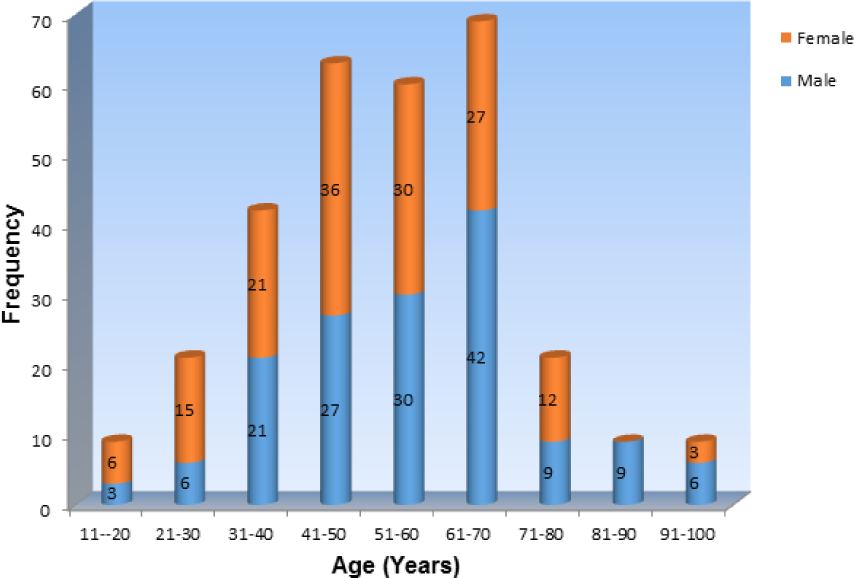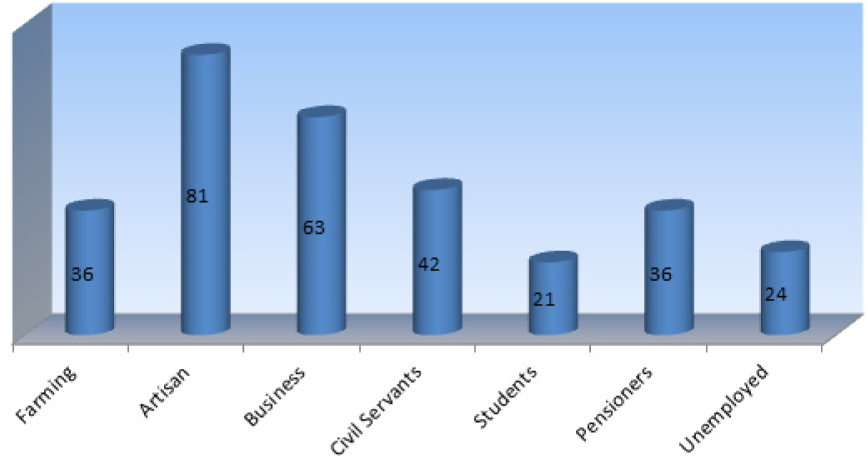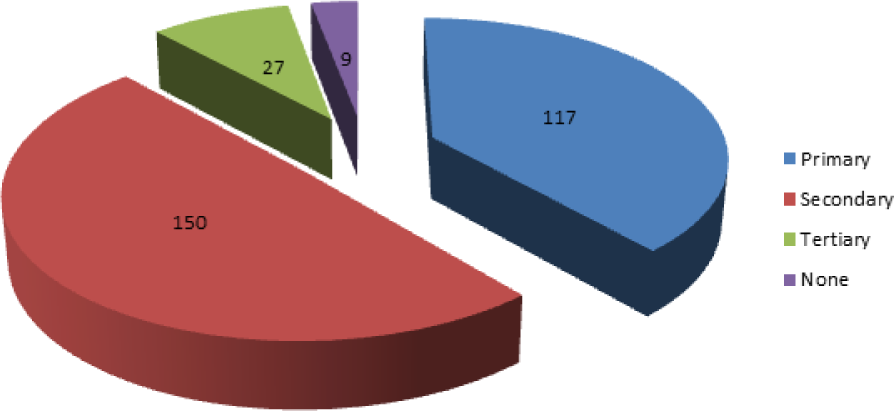Translate this page into:
Evaluation of Patients’ Perception of Services Rendered in a High Volume Primary Eye Care Center in Nigeria
*Email: favouredolu@yahoo.com
Abstract
Aim:
To determine patients’ perception of services rendered in a high volume Nigerian primary eye care center.
Methods:
ex post facto research design was used. Participants' socio-demographic profile was obtained using a pretested questionnaire. Data analysis was by SPSS version 20.0.
Results:
Of the 303 patients (156, 51.6% first timers; 147, 48.5% were old patients), 153(50.5%) were males and 150 (49.5%) were females. The age range was 13 years to 94 years with a mean of 53.8+17.05 years. Overall satisfaction with care was 98.3% with waiting time constituting the highest level of dissatisfaction (22.5%).
Conclusion:
The high patronage of this eye center can be linked to the high level of satisfaction of the patients.
Keywords
Eye care
Nigeria
Perception
Satisfaction
Introduction
In recent years, patients’ perspectives have played an increasingly important role in health care.1 Patient-centered care is health care that is responsive to patients’ wants, needs, and preferences and has been the trend of modern health care. Evaluation of patients’ perception of eye care services can be viewed as an opportunity to ‘consult’ with clients about their experiences. It may provide the only means for patients to express concerns about the services received, and to express their views about new services that can be added or improved upon.2
Perception evaluation can address: the reliability of services, or the assurance that services are provided in a consistent and dependable manner; the responsiveness of services or the willingness of providers to meet patients’ needs; the courtesy of providers; and the security of services, including the security of records.3 Specific questions may assess patients’ views about: the physical setting of services, the helpfulness of support staff, information resources, the competence of counselors, the costs of service, the relevance of services to their needs, the accessibility of services, waiting times for service components, frequency of appointments, time spent with counselor, the ‘humanness’ of services and the effectiveness of services in ameliorating their problems.4
Surveys on perception of patients assessing private eye health facilities are limited. This poses serious challenges when information is required for eye care developmental plan. Therefore, it is the thrust of this study to determine patients’ perception of services rendered in a high volume non-governmental primary eye care center in Nigeria with a view to adding to existing knowledge on this subject.
Methodology
The study was carried out in a primary eye center, located in Abak, a rural town and the head-quarter of Abak Local Government Area of Akwa-Ibom State, Nigeria. With a landmass of 190km2, It lies between 4o 59’N and 7o 47’ E in the tropical rain forest belt of south-south Nigeria. It is about 10 kilometers from Uyo, the state capital making it accessible to those from Uyo and neighbouring states.
Ex post facto design method was used because the information sought for was already present and needed no experimental testing. The study population involved patients who consented during the study period. The instrument for data collection was a pre-tested interviewer administered questionnaires which had content validity, internal validity and a Cronbach Alpha reliability of 0.84. It was designed to elicit responses based on the dependent and independent variables. With a 5% addition to account for attrition, the calculated sample size was 300. To be eligible for recruitment for the study, subjects must be registered patients, grant consent and must be able to respond to the questionnaire with or without the aid of assistance who might be an interpreter. Unregistered patients, patients whose responses were considered unreliable were excluded. One of the authors and a trained assistant administered the questionnaire.
Data was entered into a computer after coding and analyzed using SPSS version 20. Descriptive analysis was used to generate frequency tables, means, and standard deviation.
Results and Data Analysis
Of the 303 patients enrolled in the study, 153 (50.5%) were males and 150 (49.5%) were females. The age range was 13 years to 94 years with a mean of 53.8+17.05 years. Occupation and levels of education of the subjects are as shown in tables 1 and 2. Figure 2 shows age distribution by sex. Tables 1 to 8 showed responses of respondents from various service points of the eye center. Not applicable denoted patients that have not been attended to at the pharmacy and laboratory departments. Over 90% of the subjects were satisfied with registration processes and cleanliness of the premises. Other satisfaction levels were: services of doctors 96.5%, services of nurses 89.3%, waiting time (67.5%), 141 (77.1%) subjects were satisfied of the 183 who accessed pharmacy services, and 147 (81.7%) satisfied of the 180 who accessed laboratory services. Overall satisfaction with services of the eye center was 98.3%.

- Distribution by Sex.

- Occupation of Subjects.

- Educational Level.
| Responses | Frequency | Percent |
|---|---|---|
| Agree | 199 | 65.7 |
| Strongly agree | 81 | 26.7 |
| Undecided | 6 | 2.0 |
| Disagree | 17 | 5.6 |
| Strongly disagree | - | - |
| Total | 303 | 100 |
| Responses | Frequency | Percent |
|---|---|---|
| Agree | 235 | 77.6 |
| Strongly agree | 39 | 12.9 |
| Undecided | 7 | 2.3 |
| Disagree | 13 | 4.3 |
| Strongly disagree | 9 | 2.9 |
| Total | 303 | 100 |
| Responses | Frequency | Percent |
|---|---|---|
| Agree | 131 | 43.2 |
| Strongly agree | 161 | 53.3 |
| Undecided | 8 | 2.4 |
| Disagree | 2 | 0.8 |
| Strongly disagree | 1 | 0.3 |
| Total | 303 | 100 |
| Responses | Frequency | Percent |
|---|---|---|
| Agree | 169 | 55.8 |
| Strongly agree | 103 | 34.0 |
| Disagree | 25 | 8.2 |
| Strongly disagree | 6 | 2.0 |
| Total | 303 | 91.1 |
| Responses | Frequency | Percent |
|---|---|---|
| Agree | 84 | 27.7 |
| Strongly agree | 57 | 18.8 |
| Undecided | 9 | 3.0 |
| Disagree | 9 | 10.9 |
| Not applicable | 33 | 39.6 |
| Total | 120 | 100 |
| Responses | Frequency | Percent |
|---|---|---|
| Agree | 78 | 25.7 |
| Strongly agree | 69 | 22.7 |
| Undecided | 15 | 5.0 |
| Disagree | 9 | 3.0 |
| Strongly disagree | 9 | 3.0 |
| Not applicable | 123 | 40.6 |
| Total | 303 | 100 |
| Responses | Frequency | Percent |
|---|---|---|
| Agree | 119 | 39.2 |
| Strongly agree | 116 | 38.3 |
| Undecided | 8 | 2.50 |
| Disagree | 40 | 13.3 |
| Strongly disagree | 20 | 6.70 |
| Total | 303 | 100 |
| Responses | Frequency | Percent |
|---|---|---|
| Agree | 119 | 39.3 |
| Strongly agree | 179 | 59.0 |
| Undecided | 0 | 0.0 |
| Disagree | 5 | 1.7 |
| Strongly disagree | 0 | 0.0 |
| Total | 303 | 100 |
Discussion
This was a hospital-based study which focused on patients’ perception of services rendered in a private eye health institution. Most previous Nigerian studies5-9 have focused on government-owned hospitals which are not established for profits but for training, research and service. In Nigeria, services provided at public health facilities are generally perceived by members of the public as being very poor.7 Private health facilities often are more patient friendly but they are prohibitively expensive for the average Nigerian. The index eye health center under consideration is run as a Catholic Mission center that makes costs affordable to all and sundry. This partly accounts for the high patronage. The reputation of the eye center over the years also attracts patients from several states in Nigeria. Indeed the overall satisfaction of patients with the services of the eye center was 98.3%. This is much higher than what was reported in Ibadan (84%)8, Kano (83%)6, Calabar (80.1%)5 and Enugu (53%)9, which are public eye facilities. This buttresses the fact that private health facilities are more humane and meticulous in meeting patients’ needs.
Over 90% of the subjects were satisfied with registration processes and cleanliness of the premises. This is contrary to the finding in Kano6 where missing folders contributed largely to patients’ dissatisfaction. Satisfaction with cleanliness of premises cut across some studies.5,6 This may be due to the privatization of sanitation services in most public health institutions in Nigeria. This ensures that hospital premises remain tidy at all times even during union protests in form of strikes when all other workers do not come to work.
In the current study, satisfaction levels with care givers were 96.5% for doctors, 89.3% for nursing services, 77.1% for pharmacy and 81.7% for laboratory services. This was the trend reported by Iliyasu6 although the levels of satisfaction in this study were slightly higher. The reasons for this may be multifactorial. For instance, the sheer large size of public health centers can create some levels of frustration and discontentment in accessing care because of difficulties locating service points. Secondly, more empathy is likely in private health institutions and bound to create some levels of patients’ contentment.
Patient waiting time in outpatient clinics is often the major reason for patients’ complaints regarding their experiences in outpatient clinics. Therefore, patient satisfaction with waiting time plays a crucial role in the overall satisfaction with services. In the present study, waiting time had the highest proportion of dissatisfied patients (22.5%). However, this was lower than 30%6 in Kano and 74.5%5 in Calabar. Reasons adduced for undue long waiting of health seekers in a hospital include provider-patient mismatch where health seekers outnumber health givers. Non-adherence to appointment schedules, dearth of basic amenities such as electricity and water and haphazard record system characterized by missing folders are also causes of long waiting time and service delay.
Conclusion
The privately owned eye center in this study fared better than similar public institutions reviewed possibly from improved provider-patient relationships, less cumbersome organizational structure and profit-driven initiatives that ensure that eye center breaks even at month end to pay workers’ salaries.
Limitations of the study
Perception as a psychological concept is specifically the act of interpreting a stimulus already in the brain by one or more sense organs.10 As a limitation of this study therefore, a number of factors have been observed to influence perception. These include age, experience, needs and values among many other factors. 11These variables might have inadvertently affected the responses given by subjects in this study making generalization difficult. However, the information obtained provided an insight into the level of satisfaction of patients patronizing a privately owned eye outfit.
References
- Patient-centered medicine: A professional evolution. JAMA. 1996;275:156.
- [CrossRef] [Google Scholar]
- The impact of visit frequency on the relationship between service quality and out-patient satisfaction: A South Korean study-Patient Assessments Health Services Research 2004.
- [Google Scholar]
- Similarities and differences between mental health and health care evaluation studies assessing consumer satisfaction. EvalProg Plan. 1993;6:237-45.
- [CrossRef] [PubMed] [Google Scholar]
- Client satisfaction, extended intervention and interpersonal skills in community mental health. J Adv Nursing. 1993;18:246-59.
- [CrossRef] [PubMed] [Google Scholar]
- How satisfied are patients attending a Nigerian eye clinic in University of Calabar Teaching Hospital. Intl Arch Integ Med. 2014;1(4):1-9.
- [Google Scholar]
- (2010). Patient’s satisfaction with services obtained from Aminu Kano Teaching hospital, Kano, Northern Nigeria. Niger J Clin Practice. 2010;13(13):371-78.
- [Google Scholar]
- Patients’ response to waiting time in an outpatient pharmacy in Niger Trop J Pharm. Res. 2003;2(2):207-14.
- [Google Scholar]
- Patient Satisfaction with cataract surgery and posterior chamber intraocular lens at University College Hospital Ibadan and St Mary Hospital Ago-Iwoye. Nigeria, A dissertation Submitted to the National Postgraduate Medical College of Nigeria. :9-10.
- [Google Scholar]
- Patients’ assessment of efficiency services at a teaching hospital in a developing country. Ann Afr Med. 2005;4:150.
- [Google Scholar]
- Basic Concept of Educational Psychology. Vol 2011. (2nd Ed). Uyo, Nigeria: Blessed Publisher; p. :74-6.
- [Google Scholar]






